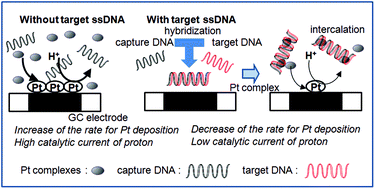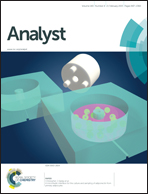A DNA hybridization sensor based on catalytic response by platinum deposition
Abstract
We report a novel electrochemical sensing system for single-stranded DNA (ssDNA) with a specific sequence based on the catalytic reduction of protons with platinum deposited by the electrochemical reduction of chloro-2,2′:6′,2′′-terpyridine platinum(II) chloride dihydrate (Pt complex) on a glassy carbon (GC) electrode. There was no catalytic property observed for proton reduction at the GC electrode, while the platinum deposited by the reduction of the Pt complex shows the catalytic activity of proton reduction. The intercalation of the Pt complex with double-stranded DNA (dsDNA) decreased the concentration of the free Pt complex with a concomitant diminution in the electrochemical catalytic current due to steric hindrance and a decrease in the diffusion coefficient of the intercalated Pt complex. Thus, the catalytic current of proton reduction by platinum deposited on a GC electrode decreased with an increase in the concentration of target ssDNA, when capture DNA with a complementary sequence was present in the solution to form the hybrid dsDNA. A detectable concentration range was estimated and found to be 0.1–1.0 μM. The catalytic current was significantly larger than the reduction current of the Pt complex, resulting in the sensitive detection of ssDNA. Furthermore, the present method is simply due to the immobilization of capture DNA being unnecessary.


 Please wait while we load your content...
Please wait while we load your content...